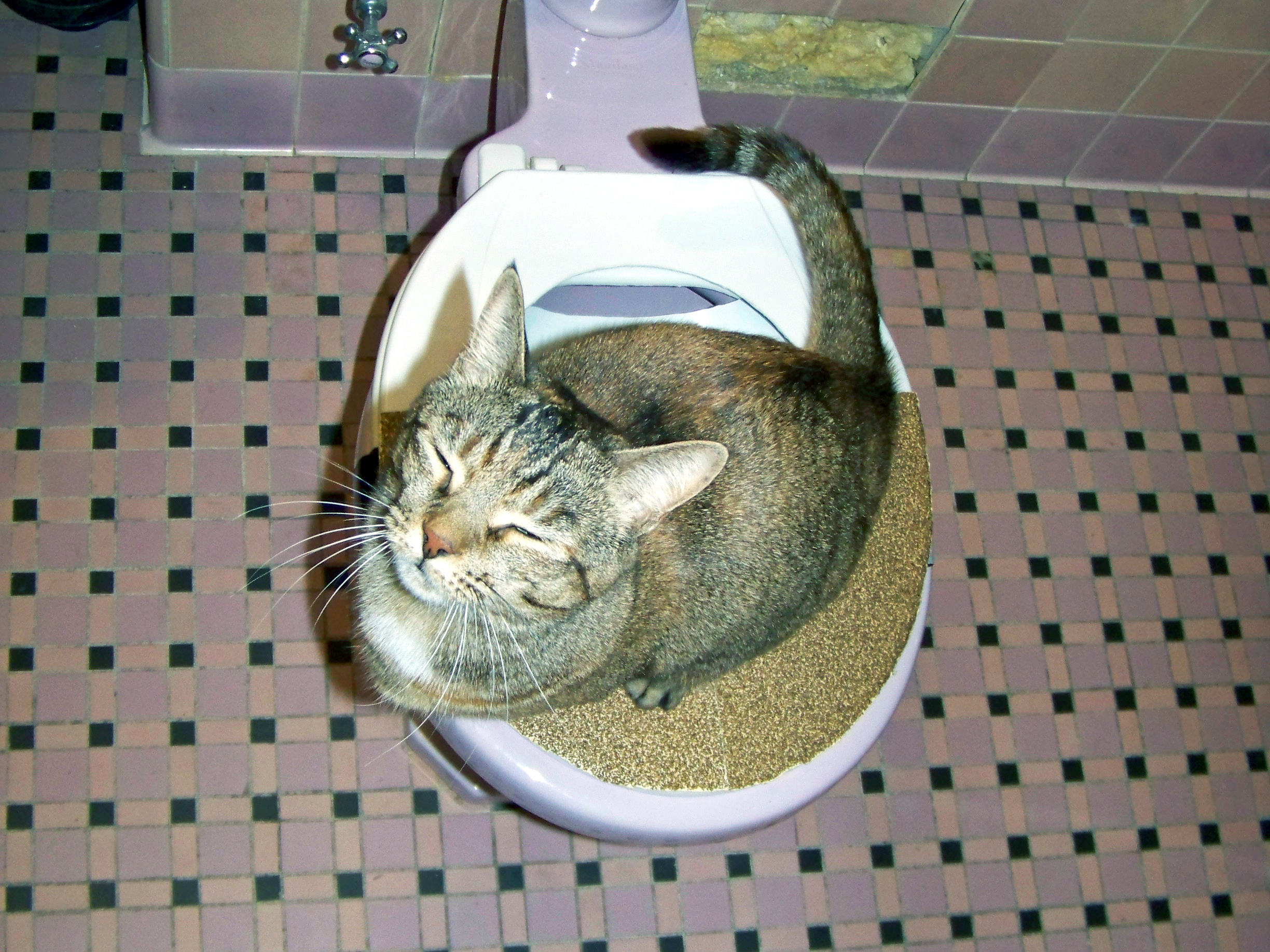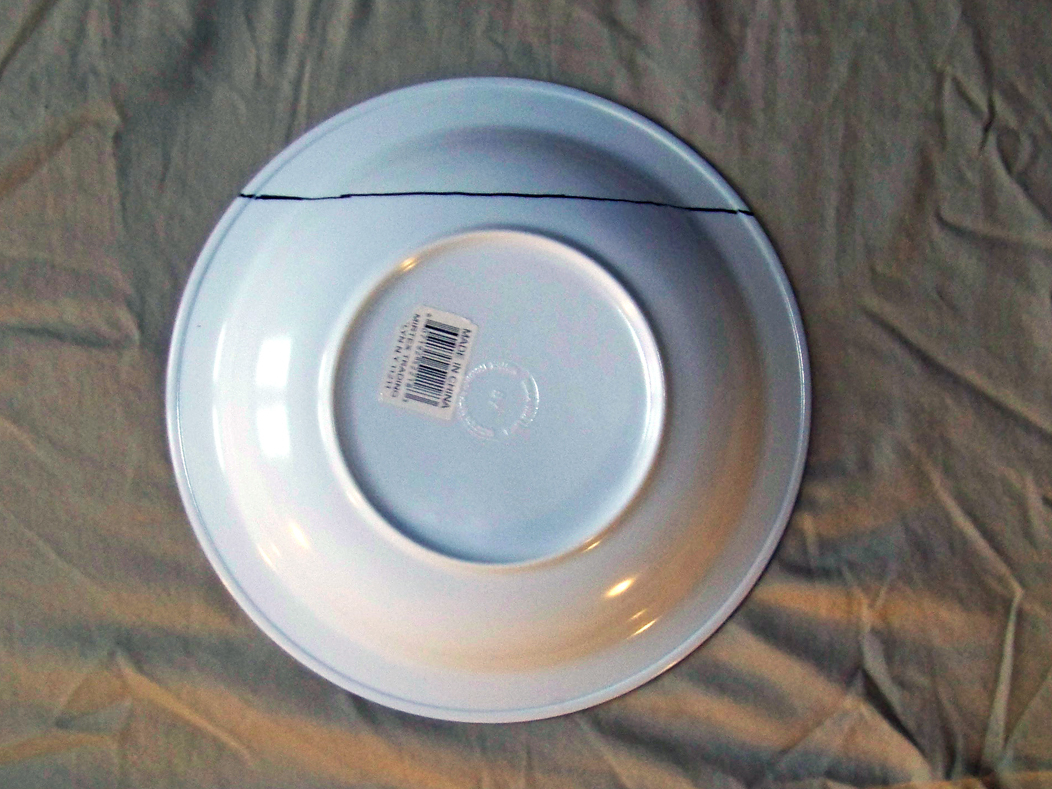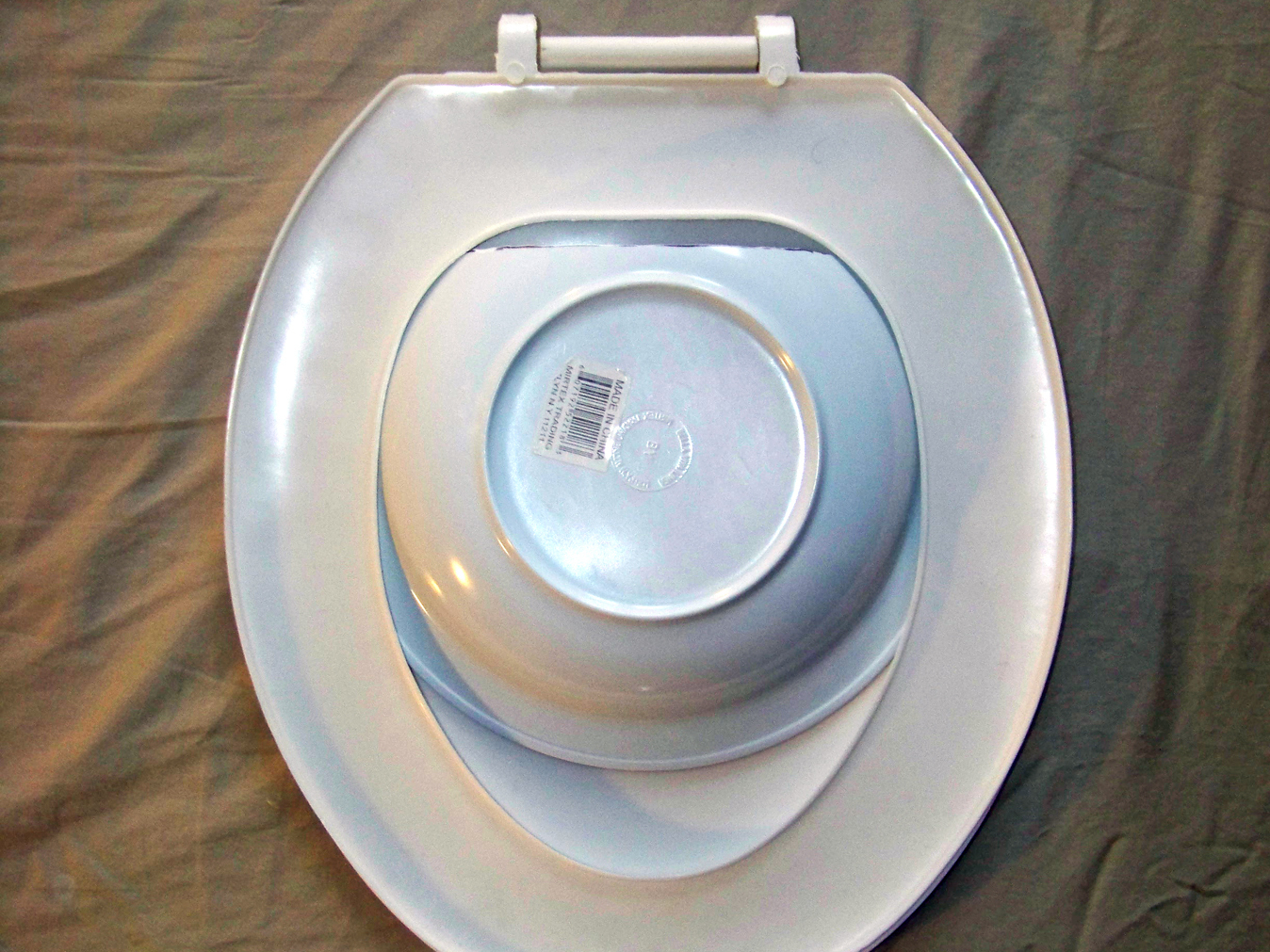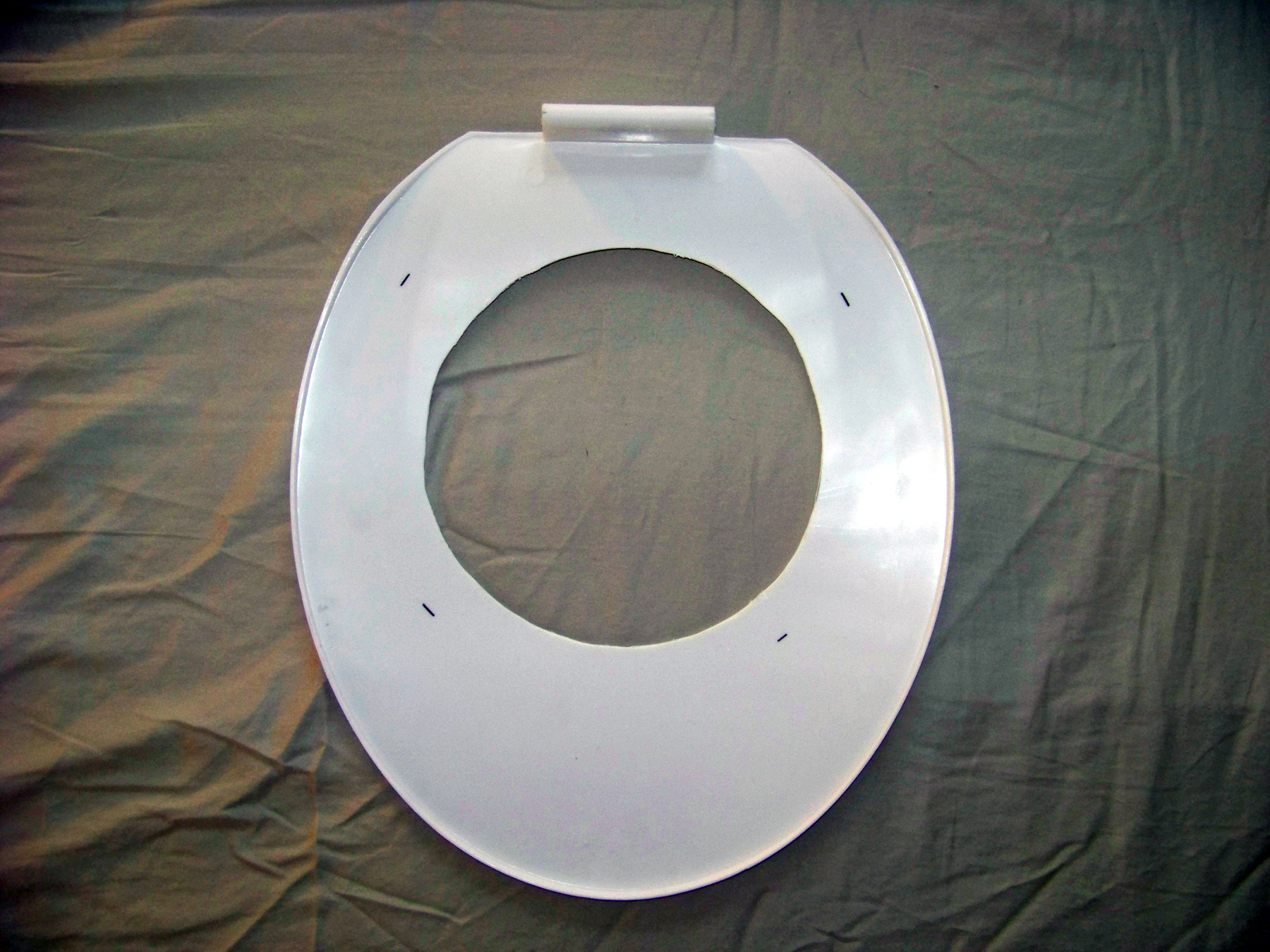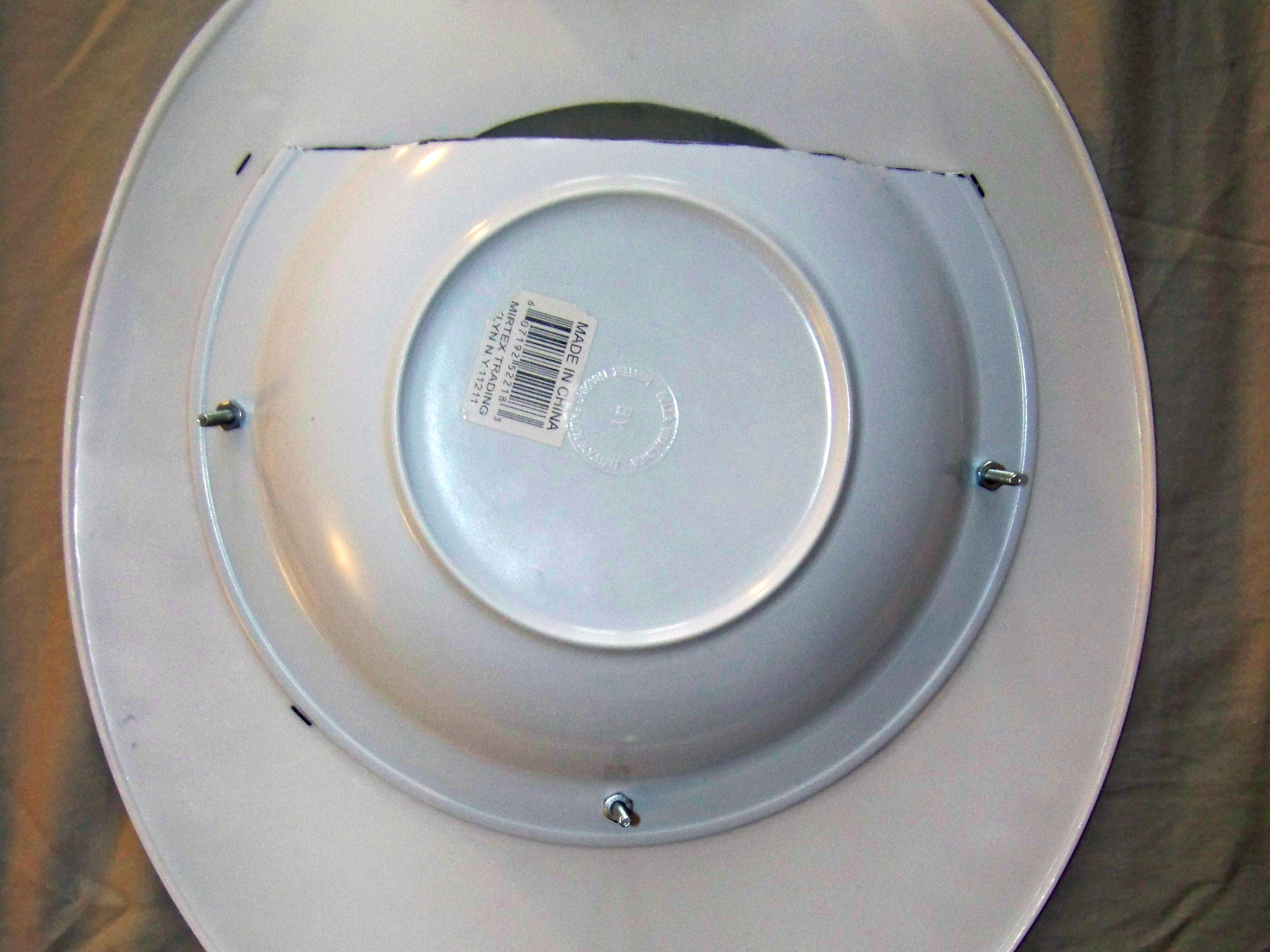Construct your seat cover litter box.
This project is easy; overall it took me about an hour to set up.
Cut off one edge of the bowl in a straight line across the point where the lip meets the flat bottom. Use a Dremel to smooth the sharp edges.
Put the bowl into the toilet seat and close the lid. Flip the toilet seat/lid upside down and lift the seat off. Mark where the bowl sits on the lid using a Sharpie.
Now you’ll cut a hole in the lid large enough that the cat can sit inside it and use it as a litter box, but leaving enough space on the front of the lid that the cat can squat there when it’s fully trained. Within the marks you made, trace a circle that you think fits the bill — I used a cooking bowl as a guide. Set the circle toward the hinge at the rear to maximize the standing space at the front of the lid.
Using the Dremel, cut the circle out of the lid. Again, smooth the sharp edges.
Drill 3 holes through the lid and the lip of the bowl for the screws— one on each side, and one on the front (non-hinged) side of the lid. The bowl should cover the hole you cut in the lid, with its sheared-off edge facing the hinge.
Screw the bowl to the lid . Seat it as snugly as possible; if it wiggles or shakes, the cat may feel insecure and not take to it as quickly. Depending on the placement of the screws, you may have to Dremel off the rest of the screw so the lid sits properly on the seat.
Use a corner of the sandpaper to sand down half of the topside of the lid, at the front end. This provides some texture for glue to adhere to.
Glue the back of the sandpaper to the part of the lid you’ve textured, and let it dry. The flatter the bond, the less likely your cat will find something to object to.
Affix the seat and lid to your toilet, put some flushable cat litter in the bowl, and start training!
Train your kitty.
You should have your cat using this system within a month (but please see the warnings at the bottom).
Like most things involving animals, the idea here is simple in principle and difficult in practice; some cats will take quickly to some parts of the process and others may not. If your cat has trouble, go back a step or two until it seems comfortable.
It can be helpful to use treats to reward the cat for jumping up onto the toilet lid. As your cat gets better at this, you can delay giving it the treat until it stands on the correct part of the lid, and once it masters that, until it sits down there. This is called operant conditioning (Google “clicker training” for the latest trends in this process). Here are the basic steps:
1. Move the cat’s litter box next to the toilet. If your cat is freaked out by this, move the box back to within 1′ of its original location. Move it 1′ closer to the bathroom every day until the box is directly up against the toilet.
2. Gradually raise the litter box by placing it on something solid and stable (like phone books); you can tape it in place to secure it. Raise it every day until it’s as high as the toilet. If your cat seems comfortable jumping up into the box, speed this part of the process up. If it has trouble, go slower.
3. Move the box over onto the toilet seat and tape it down. Reduce the amount of litter in the box until it’s only 1″ deep.
4. Replace the litter box with the apparatus you built. Put a 1″ layer of litter in the bowl.
Steps continued.
5. Every third day or so — or whenever the cat has used the system successfully for 2 full days — Dremel off about 1″ from the bowl. Cut it back from the straight cut you originally made, so that the standing surface inside the bowl gradually diminishes toward the front of the lid. This should force the cat to stand more and more on the lid and less and less in the bowl.
6. Once you’ve cut away all of the bowl, remove it entirely. Voilà — you have trained your cat to use the toilet. You can scatter some litter on the water to encourage your cat through this final stage.
Again, each cat will take to these stages differently. My cat skipped straight to stage 4 and then got very finicky about 5 and 6. Other cats have taken forever to recognize that the litter box had moved to another room, and then immediately started doing their business in the toilet. YMMV, so go as slow as your cat wants to — remember that cat pee smells awful and an annoyed cat can use it on your furniture at any time.
Conclusion
Tips
- Confident, approval-seeking cats typically take more readily to toilet training than skittish cats.
- Wait until the cat is comfortable with each stage before advancing. If you rush it, the cat will get uncomfortable and may reject the entire process permanently.
- Don’t try to force the cat to do anything it doesn’t want to do — you shouldn’t have to pick it up and put it in the litter box, for example. If the cat’s not figuring it out, use a treat to tempt it into modeling the correct behavior, and if it resists (or behaves for the treat but not on its own) you’ve moved too quickly from one stage to the next. Go back a step or two and proceed more slowly.
- Indoor/outdoor cats are likely to hold it while inside and wait until they can go out, which can lead to urinary tract infections. If they don’t take to the training right away, give it up. (See warnings below.)
- It helps if you’re around to be available for training. If you’re at the office 12 hours a day, your cat will make its own solution for relieving itself.
- Flushing after the cat uses the toilet can help.
- Once the cat is successfully using the system, reward it with treats after each success to reinforce the behavior. This is particularly handy from stage 4 on.
A Word of Warning
There are a few big issues to keep in mind when deciding whether to try to toilet-train your cat:
» Don’t teach your cat to flush. Once it learns, it will find this an entertaining way to pass the time and your water bill will skyrocket.
» Don’t toilet-train if you live near a body of water where river or sea otters live. Cat feces can contain a protozoan called Toxoplasma gondii that is known to kill otters.
» This is the big one: If your cat isn’t taking to the toilet within a month’s time, quit trying (at least for a few months). Domestic cats are very prone to urinary tract infections, which can kill them if left untreated. Most often these occur when a cat is holding its urine, which it’s likely to do if stressed or uncomfortable with its toilet situation. Your cat may simply not be a good candidate for using the toilet, in which case it’s better to let the cat have its way.
Signs of urinary tract infection include (but are not limited to):
- urinating in inappropriate places
- frequent urination in tiny amounts
- excessive genital licking
If you observe any of these signs, see your vet immediately.
''This project first appeared in MAKE Volume 20, page 144.


